Tall cactus plants, yes there are so many tall varieties of cactus plants that are not only wild but can be grown in the garden as well. Cactus plants grow into huge trees and some of them take many years like Saguaro grows fully in about 200 years.
If you want a tall cactus as a houseplant, you have to purchase a grown-up plant as cacti are slow-growing in nature and it can take hundreds of years for a cactus to reach a certain height and attain maturity. One more thing that you should remember is not to overwater a cactus plant as it can live for months without water.
Let’s know these ten tall cactus plants with names as you may also find any one of them suitable for your garden.
10 Tall Cactus Plants With Names
-
Saguaro Cactus (Carnegiea Gigantea)
Saguaro cactus is a tall columnar cactus with a few branches that has white flowers and a ruby-colored, scaly, sweet edible fruit and is a native plant of Mexico and dry areas of the southwestern U.S. and can grow up to 50 feet or 16 meters, that is the reason it is called giant cactus. This slow-growing cactus can take 10 years to increase an inch in height. By the time, Saguaro cactus is 70 years old, it is six and a half inches in height. At this age, it starts blooming with milky white flowers that release a sweet scent in late spring and early summers.
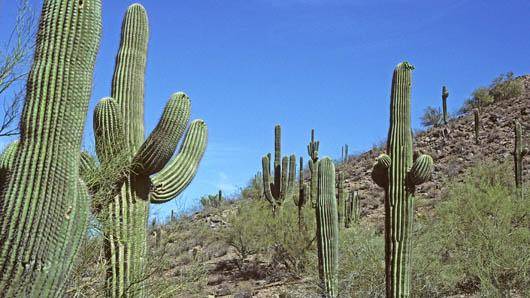
Saguaro is 15 to 16 inches tall in 95-100 years and grows its first solid arm. Saguaro cactus attains maturity when it is 200 years old and it can reach a height of 45 feet at this age. Some of the Saguaro cacti grow many branches at maturity, whereas others may not produce a single arm.
-
Golden Barrel Cactus (Echinocactus Grusonii)
Golden Barrel Cactus (Echinocactus grusonii) has a compelling presence in the garden or in the wild with its symmetrically barrel-shaped, pale green stem and the top part covered with bunches of golden yellow spines, but a few species can be without spines. The apex of old cacti has a wooly white patch and it is the central growing point that also bears the small, bright yellow flowers that grow in late spring to summer on mature cactus plants that get sufficient sunlight.
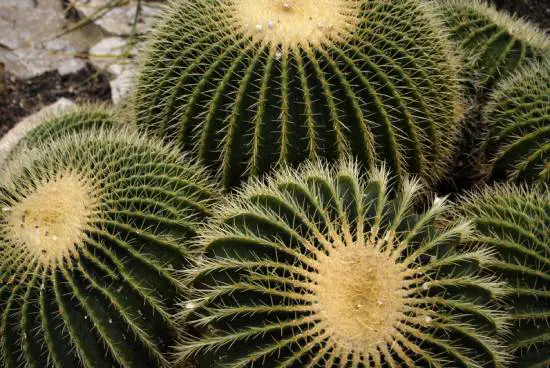
Echinocactus grusonii is fast-growing initially, then the growth rate slows down such that in 10 years, the cactus can be 10 inches in diameter, in conditions similar to the natural habitat.
These long-lasting cacti can grow 4 feet in height and 3 feet across.
Barrel cacti are perfectly round when juvenile and they stretch out to become more oval than circular as they grow and live upto 100 years.
It is very difficult to find the golden barrel cactus in the wild but it is not vanishing due to its growing popularity as a garden plant. These cacti flower only outdoors as it can be difficult for them to bloom indoors. The golden ball has a spherical body giving it a pincushion shape, hence it has got the name mother-in-law’s cushion.
-
Totem Pole Cactus (Pachycereus Schottii)
Totem poles are the huge magnificent sculptures that are admirable and are native to deserts of north-western Mexico and the Baja California peninsula, but some species are also located in southern Arizona.
These special cacti are similar to the columns of totem poles and Totem Pole Cactus is a slow-growing cactus, when grown outside can take years to gain a maximum height of 10 to 12 feet and is oblivious to the insect pests and diseases, if not over-watered.
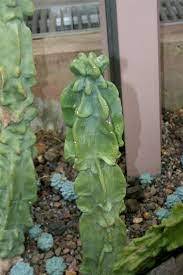
The cactus is claviform in shape and an easy-going plant making it enjoyable to grow at home and ideal for beginners. The stem is green and irregularly shaped with some areolas and odd-shaped nodules.
Totem pole cactus can reach 6 inches in diameter and develop a silvery sheen appearance. A fully matured totem pole cactus can grow up to 10 to 12 feet in height. One unique feature of this cactus is that it blooms at night and the flowers with light pink shade emerge in late spring.
-
Candelabra Cactus (Myrtillocactus Cochal)
Myrtillocactus Cochal popularly known as the Candelabra Cactus or Cochal, is a flowering species of cactus and is a native to Mexico and can be located on the hills of the Baja California peninsula.
Candelabra Cactus is not only an ornamental plant but plays a vital role in the overall well-being of our surroundings. Their small and fascinating flowers attract pollinators like insects or birds including hummingbirds.
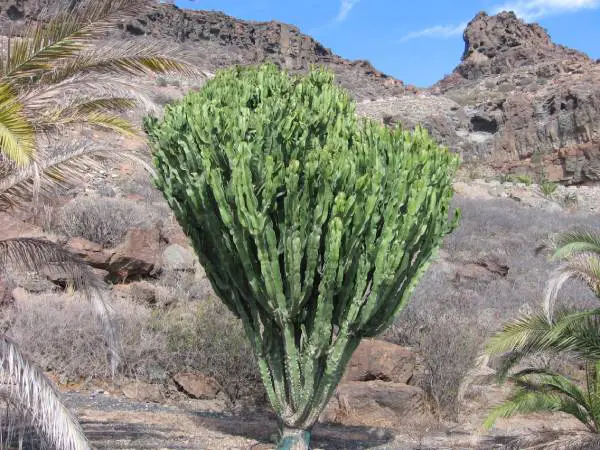
The fruits of Candelabra cacti are very tasty and juicy. These fruits are similar to blueberries in appearance and taste like strawberries, so many recipes are made with these fruits. They can be added to drinks, desserts, and candies.
Candelabra cactus is a large cactus that grows on the hills and can increase up to ten feet in height and ten feet in width. If conditions are favourable, candelabra cactus goes up to 40 feet tall and develops an apex about 25 feet wide.
You can identify this cactus with its cup-shaped flowers that open as the sun rises and close when the sun sets in the late spring to early summer.
Candelabra cactus is an exceptional plant with a distinct woody stem having a beautiful funnel shape, ivory flowers, and dark green branches.
-
Golden Ball Cactus ( Parodia Leninghausii )
Native to central South America, Golden ball cactus, Notocactus Leninghausii, lemon ball or yellow tower cactus as you call it, grows into large clumps. As the name implies, the small plant resembles a furry gold globe, but as the cactus grows old, it becomes taller.
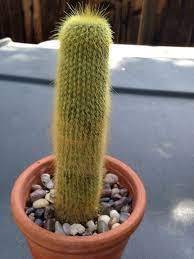
Golden Ball cacti have soft, long yellow spines that appear like golden hair. These spines impart a gold glowing tone to them and are very soft so Golden Ball Cacti are easier to hold as compared to other spiked cacti.
Yellow Tower is another name given to this cactus because as it ages, it grows into tall columns that give a very different view from the young plant. These cacti grow very slowly taking many years to grow into large clusters and will remain small if kept in a small pot.
Although they like a warm and dry climate, they are more adaptable than the other cacti and can survive in temperatures that can be freezing.
Wild species can attain a height of 24 inches and width 4 inches. Parodia can survive in less sunlight and more water, unlike many other cacti. Large, yellow flowers appear on the mature plants, on the top of the tower that is really eye-catching.
These balls are fire-resistant, hence are excellent for shielding the natural environment from fire.
-
Mexican Fence Post Cactus (Pachycereus Marginatus)
Pachycereus Marginatus or Maxican Fence Post is one of the most common plants from the cacti family and is a native plant of Central Mexico, where it is found in abundance.
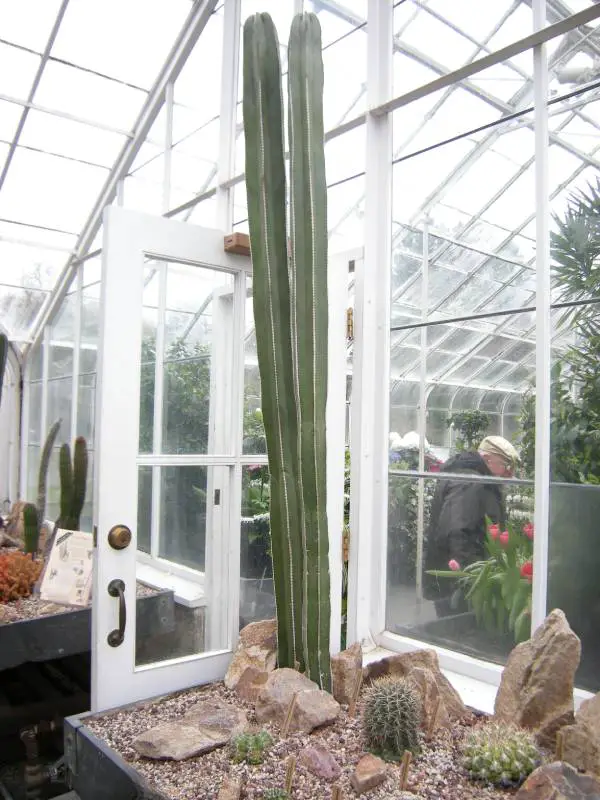
A tall columnar cactus, Pachycereus marginatus can grow as tall as 15 meters high in nature and about four meters high as a houseplant. It has got the name Maxican fence post because Maxicans use it as a fence post. Its spiral spines are yellowish to gray in color. Mexican Fence Post Cactus grow individually in columns and are generally used as a living fence in gardens. The cactus will not only decorate your garden with attractive posts but also with pretty blooms appearing in mid and early spring.
For Mexican fence post cactus to flourish well, water it frequently in summers.Protect the plant from frost and it survives best in the temperature 25°Fahrenheit to 50°Fahrenheit.
Plants need direct sunlight in spring and summer and water it only when the soil is completely dry. In the winters, these plants undergo a dormancy period.
If you want to give a striking appearance to your garden, plant these beautiful posts near walls.
-
Cowboy Cactus (Euphorbia Acruensis)
A native to South and West Africa, but it is also grown in Florida, Cowboy cactus is also popular as Euphorbia. Euphorbia Candle cactus are remarkable potted types and have a very huge dark green, columnar appearance.
Desert Candle Cactus has lean ribbed stems growing like a chandelier and has small oval leaves on the circumference.
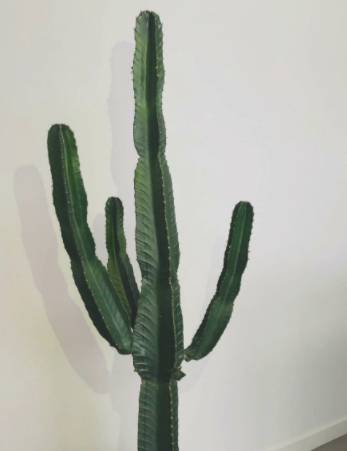
Milky sap can be allergic to the skin and eyes of some people if the plant is injured, so wear gloves and goggles to avoid eye contact every time you handle this plant.
They are least demanding of your time if they get sufficient light and water when dry. The slow-growing plant can grow well indoors as long as it gets enough light and air. The plant grows 1.5 meters tall in favourable conditions. If you have children and pets at home, it is better to avoid planting cowboy cactus indoors as the spines and the milky sap can be harmful to them.
-
Old Man Cactus (Cephalocereus Senilis)
The old man is one of the most common cacti you will find in gardens and the wild. It is popular as the old man cactus is easy to propagate in seeds and cuttings as well. The old man Cactus grows tall and has a columnar appearance with its body covered in long and wooly hair like a beard and this is how it got its name. It can grow up to 49 feet as an outdoor plant and a potted old man cactus grows really slow but looks great. White to pinkish flowers appear on the old man cactus when it is 20 feet in height. These stunning flowers appear only at night and the old man cactus produces pinkish-red fruits enveloped in yellowish hair. Plant the old man cactus in groups to increase its beauty.
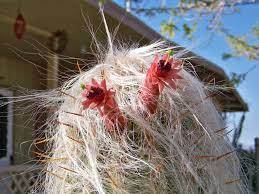
Young old man cacti are totally covered in white hair whereas the older ones have hairs only on the growing apex of the stem. While the wooly hairs can appear encouraging to touch, it is better to stay away from them as it has very sharp spines under the wools.
-
Eve’s Needle Cactus (Austrocylindropuntia Subulata)
The name needle can fool you that this is a needle-sized plant but it grows up to 13 feet tall and 10 feet wide in its natural habitat. The plant also has cylindrical, green-yellow leaves growing up to five inches when the cactus is mature.

Eve’s needle got its name from the many sharp and tall spikes. Young plants don’t have the spikes, but the older ones have enough of these yellowish-red and needle-like spikes. This cactus rarely blooms with coppery red, snowy flowers that are very attractive and develop into thick, round, spiny, and edible fruits that can be up to 10cm long.
Avoid planting Eve’s needle indoors as the spines can be dangerous to the skin and clothes. Water regularly but don’t overwater or it can rot.
-
Organ Pipe Cactus (Lemaireocereus Thurberi)
Organ-pipe cactus grows up to 5–8 meters tall and has many tall columnar branches arising from the base or above it and has a lamp holder-like appearance. The stems are ribbed and green to gray in colour, thickly covered with brown spines. The white flowers have many petals that are often stained pink or purple. The flowers are typically pollinated by bats as they bloom at night. The fruits are red in color and are sweet and fleshy.
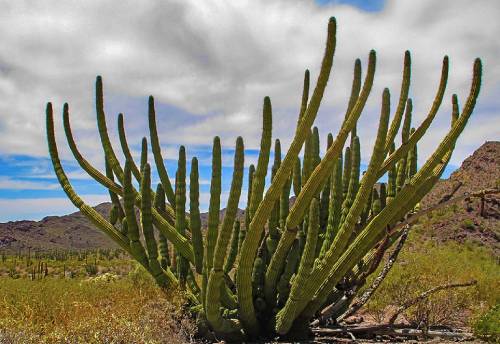
They got the name organ pipe because of their many arms growing like pipes of church organs. Organ pipe cactus can grow as long as up to 30 feet with 30 feet wide in clusters.
The organ pipe cactus blooms in spring, in the evening. You can grow them as hedges or on terraces.
Conclusions
I hope these ten tall cactus plants with names will give you an idea to pick any one of them as an addition to your family of succulents.
